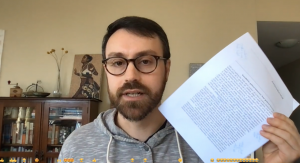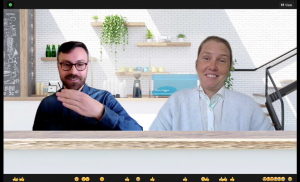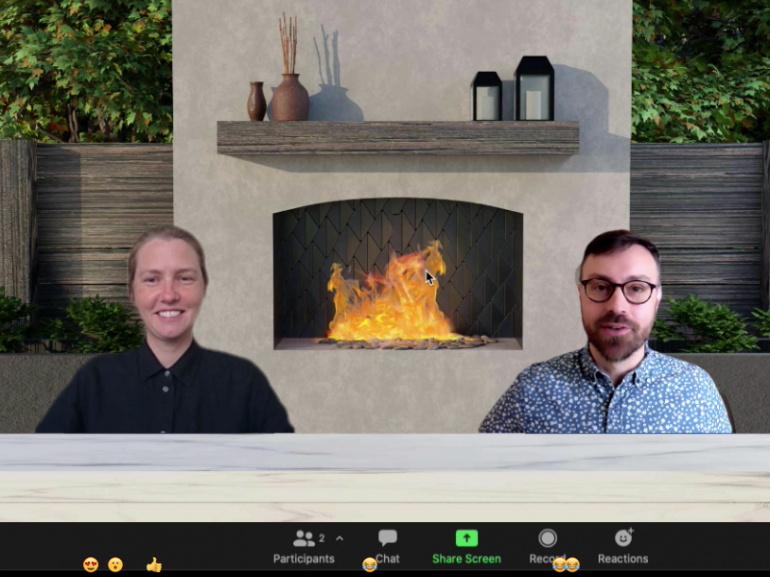As many of us know, virtual teaching can present a range of challenges for both students and teachers. Building community, communicating clearly, and introducing complex topics often feel much harder in online spaces. To help address these and other concerns, I conducted an experiment while teaching remotely in Sydney, Australia during its strictest and longest COVID-19 lockdown in 2021: I recorded and posted a ‘Weekly Preview Video’ for my unit.
I adapted this idea from a post I saw on Twitter, where a professor recorded weekly videos of himself discussing each assigned article, book chapter, etc., and the reasons he chose them for the unit. In short, his videos aimed to help students understand and engage more deeply with unit content. From this starting point, I took the idea and ran with it, adding some new elements described below.
Before delving into the details, however, I should briefly describe the context. I used the videos within a large, compulsory, second-year unit that explores sociological aspects of difference (e.g., race, socioeconomic status, gender, sexuality, religion) and their intersections with teaching, learning, and schooling. The unit is designed to draw on the sociological expertise of educational researchers within our School/Department, who each offer one or two lectures across the 12-week unit. In 2021, for instance, seven different people offered lectures, most of whom had no other role in the unit. As a result, students may not know them or their research beyond this singular 50-minute lecture. Finally, I should note that before COVID-19, these lectures were offered live, providing a unique opportunity for students to connect with and learn from the researchers in person. But due to COVID-19, and like many other things in higher education, these lectures have looked very different in recent years.
What’s in a Weekly Preview Video?
As noted above, I loved the idea of introducing the readings, but felt that a Weekly Preview Video could accomplish more than that, especially during the stark season of disconnection and uncertainty we were all experiencing.
So here’s what my videos typically included:
- A brief welcome from me and some relaxed banter with the week’s Lecturer. In addition to standard greetings, we often used a unique or immersive Zoom background that allowed us to goof around and respond to it.
- A short introduction to the assigned readings and other materials (e.g., podcasts, blogs, or other stimuli to review). Like many units, most of our assigned materials were readings, so I always tried to have physical copies with me in the videos. This way I could hold them up and page through them as I briefly described some key points or ideas that I wanted students to consider. These physical copies also contained my own highlighter markings and handwritten annotations, such that students could visibly see that I, too, was engaging deeply with the readings.
- A swift introduction to the Lecturer. Because this second-year unit utilises the diverse expertise of our academic staff, which may be unknown to the students, it was important to briefly introduce their name, title, and body of teaching and research work. I also tried to make a personal connection to enable a smooth transition, and to help students see a collegial relationship between us as lecturers. This seemed especially important since all of us were missing regular interactions and the interpersonal asides and jokes that happen more incidentally when in person.
- A concise lecture preview from the Lecturer. The Lecturer – as my guest – would then provide no more than three key points or ideas they planned to address in their lecture. We know from learning theories that previewing material is immensely beneficial in helping students engage with and retain new information, so this mini section served a primer for the actual lecture that students would watch later.
- A quick closing, usually framed with additional banter. After the lecture primer, I would sometimes make a connection or reflect briefly on the Lecturer’s response, then thank them for coming. We’d banter briefly – about the Zoom background, the weather, weekend activities – and then I’d look directly into the computer camera and offer students any pertinent reminders about the unit, and wish them well as they went throughout their week of (virtual) learning.
You may have noticed the adjectives used in the descriptions above (e.g., brief, short, swift). They’re used intentionally because none of the videos were more than 5 minutes in duration. Achieving this brevity was not easy – especially for us as academics! – but my intent was to create content that students might watch voluntarily, ‘bonus content’ which connected them to the unit topics and to us as coordinators and lecturers. I knew that if the videos were too long, or too boring, students were more likely to disengage.
Does it work?
To be honest, I had no idea whether this would work; it was a true experiment – one I hadn’t conducted before. But to my surprise, students loved the videos!
The Weekly Preview Video from Week 1 of the semester, for instance, was viewed by more than 85% of the 439 students enrolled in the unit, despite multiple unit communications that the Weekly Preview Videos were entirely optional (unlike the actual lectures). While there was some drop-off throughout the semester, as one would expect, even by Week 8 more than 300 students (nearly 70%) were engaging.

But more importantly than the sheer number of ‘views,’ it seemed the Weekly Preview Videos indeed contributed to a broader sense of connection to the unit and its content as well as to us as scholars and educators. Students noted the following in end-of-semester surveys:
- “I personally really appreciated how the coordinator made short overview videos on the readings because it really help clarify the content covered in the weekly readings.” (Student 1)
- “Loved the brief intro videos to each module – helped me dip my feet into what topic we’re going through this week, and seeing our lecturer and unit coordinator chat comfortably about the module made me feel more connected to it, rather than going straight into a lecture recording by myself.” (S2)
We also received many general survey comments that, while not directly attributable to the Weekly Preview Videos (we all know open-ended comments vary widely in their specificity), may have been influenced by them. For example, students noted the unit “was accommodating of students during the lockdown and made online content accessible” (S3) and included a “variety of different learning mediums – readings, videos, podcasts” (S4). One student, in particular, appreciated how “the lecturers are super friendly and engaging, having a perfect combination of theory and content that could be applied practically.” Inconclusive as the evidence may be, it seems likely that the Weekly Preview Videos contributed in some small way to these and related sentiments from students. How else would they know the lecturers were super friendly?
How does it work?
I’ll conclude by offering some insights on the process and what I learned along the way.
On the communication side, producing a Weekly Preview Video involved emailing each lecturer about a week in advance to describe the initiative, seek their interest (thankfully no one declined), and schedule a 30-minute Zoom call to record the video (most calls took less than 15 minutes). I also included links to previous a previous Weekly Preview Video so lecturers could get a sense of the genre (note: I gave the first lecture so did the first Weekly Preview Video by myself, and while the solo banter was terrible (!), it served as a helpful, early exemplar to send in the communications with lecturers).
On the tech side, I simply used Zoom to hold the virtual conversation with the Lecturer, and screen capture software to record it. This allowed me to easily edit the videos before posting them on Canvas. It also enabled viewers to add emojis while watching, which based on the numbers of emojis added to the videos, students seemed to enjoy. One student appreciated this ability “to show emotions and reactions through emojis…considering we have all been at home…it’s nice to feel seen through self-expression” (S5).
Finally, as with any pedagogical experiment, I learned some lessons along the way. First, five minutes goes by extremely quickly. Thus, it sometimes took two attempts during a Zoom call with a Lecturer to record a concise video. Thankfully a third attempt was never necessary. Second, sometimes the volume between us as speakers was an issue. This was likely due to different computer/microphone setups, but it’s something I hope to improve in the future. Third, the best videos seemed to skilfully weave together jovial collegial banter, deep insights about the content, and helpful information about the logistics of the unit. They also offered a personal connection, even in virtual and remote learning. Getting this balance right wasn’t easy, however. Just like a trailer or the first season of a show on Netflix, it takes some time to grow into the genre. Even within this one-semester experiment, I noticed differences between the earlier and later videos. I now have a stronger sense for how to facilitate and produce these Weekly Preview Videos in the future.

So, will I? Absolutely. To me, the benefits for students far exceed the costs. They took minimal time to prepare and, to be honest, were just plain fun. I got to sit down with colleagues I enjoy, to talk about issues that are immensely important to me. And if the students benefited along the way, all the better.
Here’s an early example, before we figured out the immersive environment, and one from later in the unit with a bit more banter and personalisation.
Matthew A. M. Thomas is a Senior Lecturer at the University of Sydney, where he teaches and researches pedagogy, policy, and teacher and higher education. He is the co-editor of Examining Teach For All (2021) and the Bloomsbury Handbook of Theory in Comparative and International Education (2021). He tweets at @MThomasEdDev.
Want to know more?
- The Modular Professional Learning Framework offers a number of modules that could assist in engaging and supporting large, diverse student cohorts. M15 Creating and using educational media specifically addresses generating both teacher- and student-generated educational media.
- The Learning Media team in Educational Innovation offer 1:1 consults that can help you get started. Choose the booking type ‘Educational video design and recording’ to arrange a time with them.





